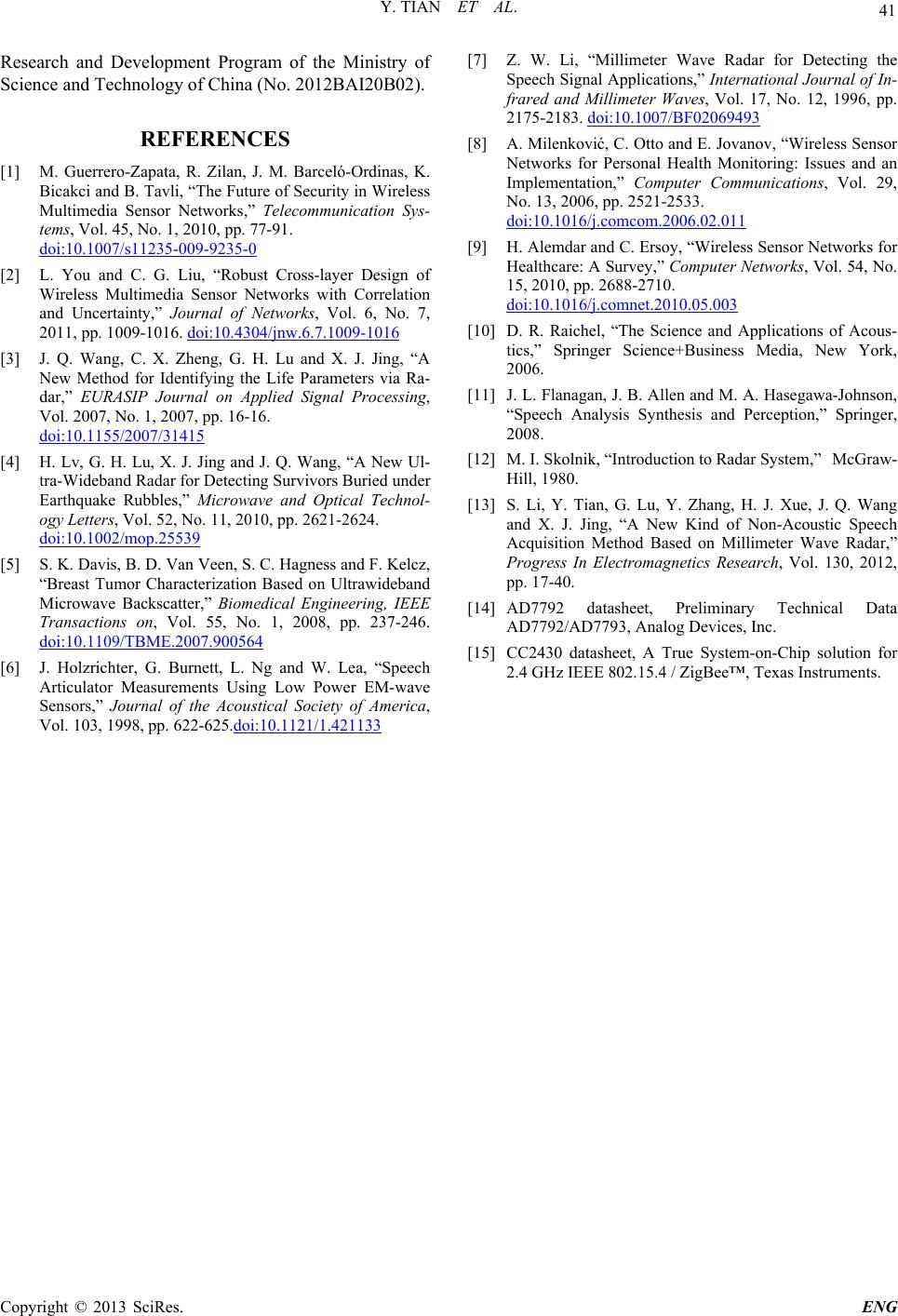
Y. TIAN ET AL. 41
Research and Development Program of the Ministry of
[1] M. Guerrero-Zapata, R. Zilan, J. M. Barceló-Ordinas, K
Bicakci and B.ecurity in W
Multimedia Sommunication Sys-
Science and Technology of China (No. 2012BAI20B02).
REFERENCES
.
Tavli, “The Future of S
ensor Networks,” Telec ireless
tems, Vol. 45, No. 1, 2010, pp. 77-91.
doi:10.1007/s11235-009-9235-0
[2] L. You and C. G. Liu, “Robust Cross-layer Design of
Wireless Multimedia Sensor Networks
and Uncertainty,” Journal of Ne with Correla
tworks, Vol. 6, No. 7,
tion
2011, pp. 1009-1016. doi:10.4304/jnw.6.7.1009-1016
[3] J. Q. Wang, C. X. Zheng, G. H. Lu and X. J. Jing, “A
New Method for Identifying the Life Parameters via Ra-
dar,” EURASIP Journal on Applied Signal Processing,
Vol. 2007, No. 1, 2007, pp. 16-16.
doi:10.1155/2007/31415
[4] H. Lv, G. H. Lu, X. J. Jing and J. Q. Wang, “A New Ul-
tra-Wideband Radar for Detecting Su
Earthquake Rubbles,” Mrvivors Buried under
icrowave and Optical Technol-
ogy Letters, Vol. 52, No. 11, 2010, pp. 2621-2624.
doi:10.1002/mop.25539
[5] S. K. Davis, B. D. Van Veen, S. C. Hagness and F. Kelcz,
“Breast Tumor Characterization Based on Ultrawid
Microwave Backscatter,”
eband
Biomedical Engineering, IEEE
Transactions on, Vol. 55, No. 1, 2008, pp. 237-246.
doi:10.1109/TBME.2007.900564
[6] J. Holzrichter, G. Burnett, L. Ng and W. Lea, “Speech
Articulator Measurements Using Low Power EM-wave
Sensors,” Journal of the Acoustical Society of America,
Vol. 103, 1998, pp. 622-625.doi:10.1121/1.421133
[7] Z. W. Li, “Millimeter Wave Radar for Detecting the
Speech Signal Applications,” International Journal of In-
frared and Millimeter Waves, Vol. 17, No. 12, 1996, pp.
2175-2183. doi:10.1007/BF02069493
[8] A. Milenković, C. Otto and E. Jovanov, “Wireless Sensor
Networks for Personal Health Monitoring: Issues and an
Implementation,” Computer Communications, Vol. 29,
No. 13, 2006, pp. 2521-2533.
doi:10.1016/j.comcom.2006.02.011
[9] H. Alemdar and C. Ersoy, “Wireless Sensor Networks for
Healthcare: A Survey,” Computer Ne
tworks, Vol. 54, No.
15, 2010, pp. 2688-2710.
doi:10.1016/j.comnet.2010.05.003
[10] D. R. Raichel, “The Scien
tics,” Springer Science+Business
ce and Applications of Acous-
Media, New York,
h Analysis Synthesis and Perception,” Springer,
80.
ing, “A New Kind of Non-Acoustic Speech
7793, Analog Devices, Inc.
s Instruments.
2006.
[11] J. L. Flanagan, J. B. Allen and M. A. Hasegawa-Johnson,
“Speec
2008.
[12] M. I. Skolnik, “Introduction to Radar System,”McGraw-
Hill, 19
[13] S. Li, Y. Tian, G. Lu, Y. Zhang, H. J. Xue, J. Q. Wang
and X. J. J
Acquisition Method Based on Millimeter Wave Radar,”
Progress In Electromagnetics Research, Vol. 130, 2012,
pp. 17-40.
[14] AD7792 datasheet, Preliminary Technical Data
AD7792/AD
[15] CC2430 datasheet, A True System-on-Chip solution for
2.4 GHz IEEE 802.15.4 / ZigBee™, Texa
Copyright © 2013 SciRes. ENG